 Facebook
Facebook
 X
X
 Instagram
Instagram
 TikTok
TikTok
 Youtube
Youtube
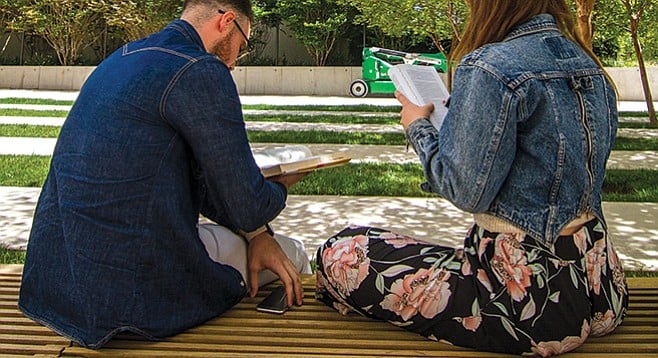
At 11:30 on a coolish Saturday morning in April, I have the bench to myself. Sometimes when I pass by, a woman with a shopping cart stuffed and piled with her belongings occupies the far corner closest to the building, but this morning, it’s all mine: 40 feet of Brazilian ipe wood slats cantilevered over a concrete base in a quiet corner of downtown San Diego. Situated on the backside of the James M. Carter and Judith N. Keep United States Courthouse in a plaza designed by Spurlock and Poirier Landscape Architects, this is my one of my favorite benches in San Diego.
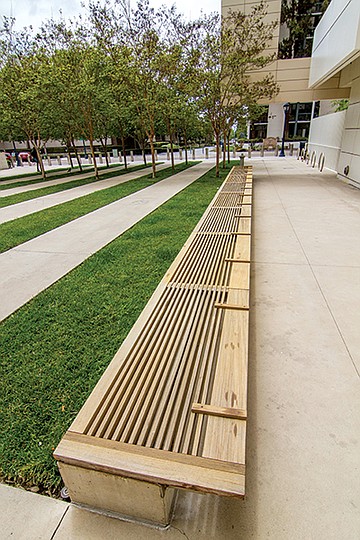
On the day I found it, I had been wandering around downtown trying to achieve 10,000 steps on my pedometer. After meandering for an hour or so with no particular destination, I found myself standing in front of the Columbia Tower Apartments at the corner of what used to be State and E.
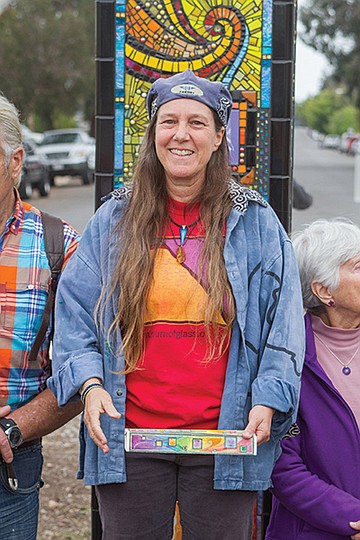
Set outside the 16-story, white terracotta-and-glass federal courthouse and what the Orchids & Onions website refers to as its “sexy” and “curvaceous” 40-foot-high entrance lobby, a small plaza features alternating rows of narrow pavement walkways and strips of grass planted with crepe myrtles.
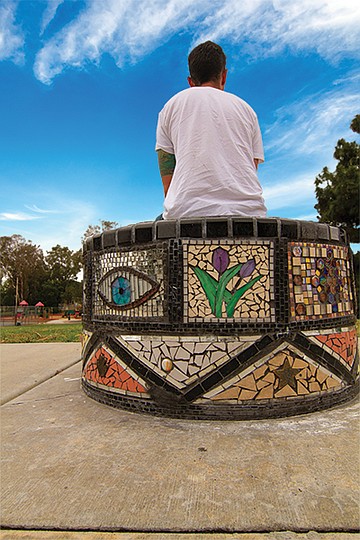
Off to the side, near the building stands a bench, a gift, an invitation to sit and enjoy the space, which I did. I am not the only one who has. A 2015 article in The Architect’s Newspaper describes the courthouse project as “a graceful departure from the lumpish mediocrity of its neighbors, [and] as a guardian of green space at the heart of the city.”
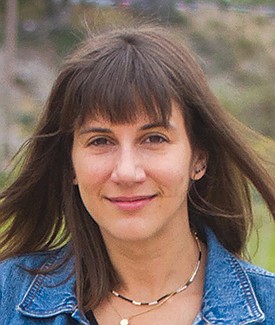
Leigh Kyle of Spurlock & Poirier is the landscape architect responsible for the square’s design. She explains that although her firm designed the plaza, the detailing of the bench was done by the building’s architects, Richard Meier & Partners, a Los Angeles firm.
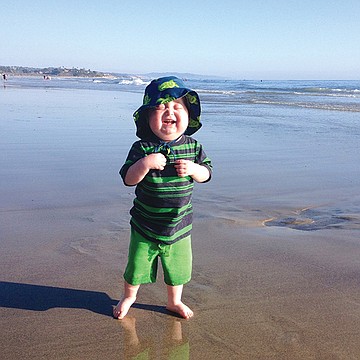
“I think what’s so strong about it is the proportions, and those proportions can be found throughout the project,” she says of the bench. “It’s a reflection of what’s going on in the paving and what’s going on in the façade of the building. There’s a very very tight geometry to the whole project, which is why they ultimately detailed it, because God forbid we got the proportions wrong.”
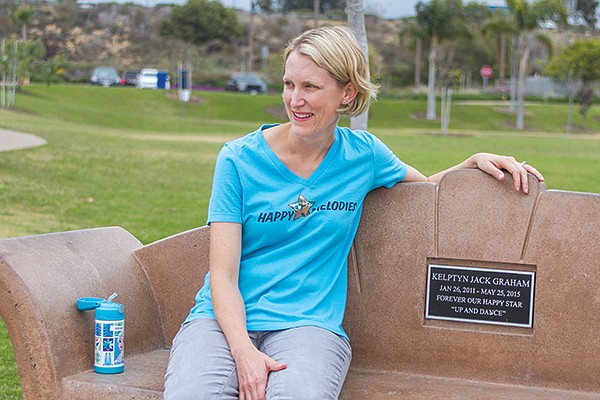
I hadn’t noticed it before she pointed it out, but not only do the slats in the bench mimic the alternating strips of grass and pavement, but the graduating height of the bench also mimics the graduating height of the retaining wall across the plaza. Recognizing this helps me understand the bench as part of a whole. I’m guessing that my response to it would probably have been very different in a less-cohesive context.
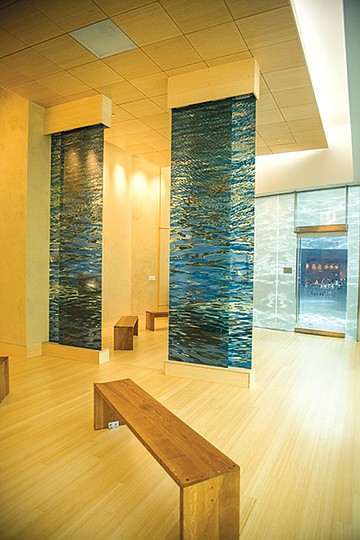
It turns out that Kyle is into benches, and public seating of all kinds. It makes sense, given her career as a landscape architect. During our conversation, she uses terms such as, “trends in seating,” and “the built environment,” and explains that this bench and the other “fixed seating” in the project were placed in strategic locations from which the public can “enjoy an orchestrated view of the plaza and of the garden.”
For the landscape architect, designing a beautiful bench means marrying practicality with vision. A good public bench has to be designed for comfort, with a seat height of 18 or 19 inches off the ground. Intermittent arms are standard practice these days, to discourage anyone from stretching out and sleeping on the benches. And increasingly, cities and other public clients want the bench to have a back. Kyle’s team at Spurlock & Poirier is currently working on a project in Carlsbad, where a vocal older population has requested backs on the benches so they can look out over the ocean while resting their backs.
“If you’re building an urban environment, you’ve got to be ready for everybody who lives there to be partaking in it,” Kyle says. “It’s very democratic, that’s the whole idea.”
These and other practical considerations are all part of the job of furnishing public spaces. But Kyle does call out one potential source of annoyance when it comes to designing public benches.
“The thing that kind of keeps us from realizing our ideal vision of street furnishing is skateboarders,” she says. “It doesn’t matter really what the material is. If you’ve got a fixed long horizontal surface that’s 18 inches off the ground, somebody’s going to grind on it. So if you didn’t think about that beforehand, you might have to go put skatestops on [your bench].”
The skatestops on the benches around the federal courthouse plaza, which wraps around to the other side of the building and stretches all the way to Broadway, are small pieces of wood that have been placed perpendicular to the slats at regular intervals down the length of the benches. They’re not quite an eyesore, but the benches would certainly be more elegant without them.
Even so, the bench is doing what a good bench does in a project like the courthouse. It’s offering an “opportunity to take five and sit down, and sort of enjoy the space that the landscape architect has created, or more importantly, to kind of just be in the moment in that context,” says Kyle, who also suggests that the public bench is an important part of a larger vision for downtown San Diego. “I think what everyone wants for downtown San Diego is that it continues to grow and get more street life and more activity and more vibrancy and more workers and residents who are walking in the streets to get to lunch or pick up their dry cleaning or whatever,” she says. “So the bench is a chance for people to not just walk down the street but also maybe stop and talk to somebody or wait for a bus or just watch the human parade go by.”
Vicki Leon is on a mission to art-ify her City Heights neighborhood of Azalea Park, which is bordered by Fairmount Avenue to the East, Interstate 805 to the West, to the North by Manzanita Canyon, and Hollywood Park to the South. As far as she’s concerned, a bench is an opportunity to further her mission. On the day we meet, she’s basking in the satisfaction of the neighborhood’s new identity sign that stands in the median on Poplar Street, just off of Fairmount Avenue. Twelve years in the making, the sign features a ten-foot-high, four-sided tile mosaic post designed by Leon and created with the help of the Azalea Park Mosaic League. The mosaic post took the group two years to make through an estimated 2000 hours of labor.
Leon started the Mosaic League in 2014 as part of the Pop Street Project, which was launched with the help of a grant — she wouldn’t share how much — from the San Diego Foundation. According to the SD Foundation website, the goal was to “bring residents together to revitalize and re-brand Poplar Street as an arts and eco district.”
Poplar Street runs through the heart of the neighborhood from Fairmount Avenue to Violet Street, and the project includes neighborhood improvements such as murals, mosaic street furniture, canyon cleanups, and xeriscaping. Leon and the Azalea Park Mosaic League began with the artification of bus stop benches and public garbage can holders.
Leon and I meet one Saturday afternoon at the intersection of Tulip Street and Pepper Drive, where two bus stop benches sit on opposite corners. These two benches are the opposite of my downtown plaza bench in just about every way. Where the teak bench is slender, rectilinear, and minimalist, these mosaic benches are round, vibrant, and colorful. And where the teak bench was placed strategically and with the intention of offering an orchestrated view of the plaza, these benches are the view.
Originally bland-looking 18-inch-high concrete cylinders with a 36-inch diameter, each bench now features 20 or so works of mosaic tile art, unified by a black frame with a colored inner border around each piece. The art on one bench includes fish, a hot air balloon, flowers, hummingbirds, and a pig in a bowtie. The one across the street showcases trees, sunshine, and birds flying over water, as well as some more abstract works.
“Everybody wanted there to be a theme, a theme, a theme. But I feel kind of strongly that when you have a theme, it’s less art,” Leon says.
So the group came up with the idea of an exhibit which allowed for the artistic expression of each individual as well as creating a visually unifying format by way of the black borders. When I ask Leon whether the art was created by mosaic artists or neighborhood residents, she says it was both. The artists are all community members, many of whom joined the group without any experience in mosaic art.
Leon considers herself “more of a generalist, as in everything is an art material, but my specialty is working with glass,” she says. “And now, my other specialty is community art, which I just got involved in, because I’m in a community now where things can happen.”
Phase two of the Azalea Park project involves the first wave of mosaic artists teaching and training a second wave so that eventually there’s an army of mosaic artists beautifying the neighborhood. But Leon admits that dreaming up a vision is easier than realizing it, especially when it requires the commitment of a number of people. At the time these two benches were created, Leon says there were about ten people who participated in the project on a regular basis, and now the number of committed regulars is closer to six.
“I started calling it the mosaic league with this idea of having different teams,” she says, “and we may get back to that, but now it’s the mosaic team. It’s one team that meets at my studio.”
So far, that mosaic team has tackled three bus stop rounds (with a fourth currently in progress) and two garbage can covers. The mosaics include hand cut glass, broken floor tiles, ceramic tiles purchased from a mosaic supply store, handmade tiles created from high-fired clay, millefiori glass tiles, and stones and rocks. The art works are created in the studio, and the mosaic pieces are glued to cloth mesh. On installation day, they’re stuck onto the bus benches with thinset adhesive (“basically cement with epoxy in it,” Leon says), and then grouted to seal in the open spaces, hold the pieces in place, and give it a polished look.
“One of the reasons why I chose mosaic as the art to bring the community together is that technically, it’s really easy. It’s like gluing macaroni on paper like you did in kindergarten, only it’s just different materials,” Leon says, “so you don’t have to spend a lot of time learning the techniques and you can get right to the artistic expression and start developing yourself as an artist.”
Getting people committed to showing up regularly wasn’t the only challenge Leon faced in the beginning. Some of the team members were new to both mosaic art and art in general, and she had to nudge and coax their creativity out of them. They might, for example, start working from a small collection of three different materials without venturing beyond it, but then she’d place a few new materials by their side, and the art would develop into something new. Just a few years later, though, the team is going professional. Not only did they play a major role in the production of the neighborhood identity sign, which was officially a project Leon had been commissioned to do, but they have also been invited to participate in a project for Little Saigon, which will be their first commission as a group.
“I kind of see the whole thing as my project, and certainly the sign is; I’m the lead artist on that; but with these,” she says, referring to the benches and other neighborhood mosaics, “it’s more about creating the opportunity for other people to become artists.”
Leon and I jump in our cars, and I follow her old Subaru east on Pepper, north on Violet, then east up Poplar two blocks to Snowdrop Street, where she pulls over to the curb in front of another mosaic-tiled bus bench and garbage can cover. When we get out of our cars, she points across the street to the fourth cylindrical cement bus bench, which is completely unadorned and sad-looking. But now that the community sign is finished, the team can get back to where they left off with this bench project. Within a few weeks, it will be a piece of community-created art.
“See this?” Leon asks, leaning over and indicating the mosaics that circle the base of the bench. I follow behind her while she points out the work of two different artists, one who created four pieces that represent the four seasons, and one who created the four suns placed between the seasons. “Those two artists are now on the core team, and they’re really good friends now, and they met through the mosaic team. That’s kind of part of the plan, to have people have a way of being together so they can get to know each other.”
So, I ask. If a bench is not just a bench, then what is it?
“These were blank canvases,” Leon says. “And bus stops are places where strangers and neighbors gather and become not strangers.”
Allison Amini and Sarah Graham have never met, but they are connected by a terracotta-colored recycled concrete bench at Encinitas Community Park. Amini likes the bench for its sight lines. It sits at the edge of the playground, from which she can keep an eye on her five-year-old son while he climbs, swings, and slides. But until her son asked her to read the plaque on the back of the bench, she never thought twice about it.
KELPTYN
JACK GRAHAM
Jan 26, 2011 –
May 25, 2015
FOREVER OUR
HAPPY STAR
“UP AND DANCE”
Amini’s son Andrew is learning to read and has become curious about the words he sees out in the world.
“So, Andrew, he comes over and he looks at it, and he’s like, ‘What does this say?’” Amini tells me. “I said, ‘This is the name of someone who passed away, who died.’”
The questions kept coming. Why is his name there? Who was he? Why does it say that?
“I was like, ‘He was born in January, two years before you, and he just died a couple of years ago,’” she says. “And he was like, ‘How did he die?’ I said, ‘I don’t know,’ so then I wound up Googling it.”
We’re sitting on the bench, watching children dizzy themselves on spinning playground toys and jump off of swings in bare feet. We shake our heads and silently fathom the unfathomability of losing a child.
Sarah Graham has lived through it, and on her blog The HoneyGrahams, she chronicled the story of her son Kelptyn’s life and his battle with Osteopetrosis from 2011 until 2015, when he died at four years and four months old. Osteopetrosis is an extremely rare genetic disease that’s characterized by overly dense bones. In its severest form, which Kelptyn had, the disease results in complications including blindness, frequent infections, fractures, inflammation, enlargement of the liver and spleen, anemia, and on and on. One in every 100,000 to 500,000 children are born with Osteopetrosis, and two thirds of them die before the age of 10. In her final blog post on July 9, 2015, Graham posted photos of the 3000-plus “beads of courage” Kelptyn collected in his short lifetime and listed procedures he had to endure, including: 34 whole blood transfusions, Cranioplasty Expansion with Jackscrews, skull bone biopsy, 7 months of daily injections 2 to 3 times per day, 2 bone marrow transplants, 10 brain/skull surgeries, and chemotherapy. In that same blog post, she included a video of Kelptyn playing the drums and singing, “When the Saints Go Marching In.”
“No matter what challenges life threw at Kelptyn Jack, he always requested to get “Up and dance,” Sarah Graham writes to me in an email, explaining both the last line on the plaque and her impetus for starting Happy Star Melodies, her nonprofit organization that brings music to children fighting life-threatening illnesses.
When Kelptyn was four months old, the family started a savings account for him. After his death, they used the money they’d saved to start the nonprofit and purchase Kelptyn’s park bench. The playground at Encinitas Community Park was the last playground he played at before he died, and he’d learned to use his cane (he was blind from seven months old) on the park’s pathways. And because the park is closer to their home than his burial site in Oceanside, the Graham family decided memorialize him there.
When it comes to memorial benches in Encinitas, Cardiff, Leucadia, and Olivenhain, Bob Keeley is the man to talk to. He’s a supervisor for the Parks and Rec Department, and he oversees “the bench programs for the city.” When someone comes in wanting to memorialize a loved one on a park bench, he helps them find one that fits.
“They usually come in with a desire like, well, they want the beach, and I don’t have any benches on any of our beach sites currently,” he says. So he’ll recommend a park near their home or one that connects with their loved one in some meaningful way. Currently, the parks he can offer include Wiro Park (5 benches available), Scott Park (10 available), Orpheus Park (3 available), and Glen Park (6 available). Of the 33 total benches at Encinitas Community Park, 9 are still available, for the average cost of $1956 each ($1650 for the bench itself, and a varying cost for the plaque and installation, depending on the inscription).
Sarah Graham didn’t need help deciding on a location. She knew where she wanted Kelptyn’s bench to be. “I just went into the civic center next to the library in Encinitas and asked the front desk about the application for park benches. At the time, the playground had only Lions club plaques up, because they sponsored the playground,” she writes in her email. “We wanted to continue our family memories with him as a part of our lives, and we knew our family would frequent this park regularly.”
Amini says she knows she cannot grasp what Sarah Graham feels, but that she does feel connected to her, in the way that she feels connected to all moms. And she really does like the bench. It’s her favorite one because of its location at the edge of the playground. Whenever she arrives at the park, if the bench is taken, she lingers nearby, ready to snatch it if it becomes free. Her son, on the other hand, always asks the same questions about the boy — What does that say? Why is that there? How did he die? — as though he’s never heard the answers before.
To ask anyone if they’re “into benches” is risky for someone who seeks to come across as normal-ish, but doing so also has the potential to yield immediate connections. The benches in the Reflection Room in Terminal 2 at the airport led me to three conversations with bench enthusiasts, including Norie Sato, the lead artist who commissioned the benches; artist and designer Miki Iwasaki, who designed and built the benches; and Lauren Lockhart, the airport’s arts program manager, who got me through security to see the benches.
In the course of our conversations, each of the three introduced me to some of their favorite benches, including some found in downtown Palm Springs, between guard rails at Sunset Cliffs, and some very arty “Eye Benches” in Pittsburgh and Seattle (by Louise Bourgeois).
The four white oak benches that brought me together with these three sit in two groups of two, one in front of 12-foot tall glass panels inset with silk-screened imagery of water and reflections of the San Diego environment, including the downtown skyline, the Star of India, and pine cones. The other two benches sit in front of an a large drum-like sculpture made of stainless steel. Their dark stain provides a pleasing contrast to the light-colored bamboo floors and Venetian plaster walls. Although Sato led the design and creation of the room, she commissioned Miki Iwasaki, a San Diego artist, to produce the benches.
“If you look carefully at the benches, you can see how beautifully crafted they are, that they’re not just your ordinary bench, but they’re not ostentatious or anything,” Seattle-based Sato says over the phone. “They’re not meant to be an object in and of themselves that you really want to pay attention to, but that they have that kind of quality and uniqueness for the space itself.”
Lockhart loves the benches in particular for the gentle slope in the seat, “this beautiful little curve that hugs you,” she says. “It’s unusual. I think it’s reflective of Miki considering the user.”
Up close, the benches look like a love affair with wood. They’re simple, elegant, natural, and clearly designed with great care. Sato tells me that in the world she inhabits, it’s not so strange to think of a bench as more than a bench. “Benches are a really great opportunity to combine sculpture with function,” she says. “And they create some moments of delight.”


At 11:30 on a coolish Saturday morning in April, I have the bench to myself. Sometimes when I pass by, a woman with a shopping cart stuffed and piled with her belongings occupies the far corner closest to the building, but this morning, it’s all mine: 40 feet of Brazilian ipe wood slats cantilevered over a concrete base in a quiet corner of downtown San Diego. Situated on the backside of the James M. Carter and Judith N. Keep United States Courthouse in a plaza designed by Spurlock and Poirier Landscape Architects, this is my one of my favorite benches in San Diego.

On the day I found it, I had been wandering around downtown trying to achieve 10,000 steps on my pedometer. After meandering for an hour or so with no particular destination, I found myself standing in front of the Columbia Tower Apartments at the corner of what used to be State and E.

Set outside the 16-story, white terracotta-and-glass federal courthouse and what the Orchids & Onions website refers to as its “sexy” and “curvaceous” 40-foot-high entrance lobby, a small plaza features alternating rows of narrow pavement walkways and strips of grass planted with crepe myrtles.

Off to the side, near the building stands a bench, a gift, an invitation to sit and enjoy the space, which I did. I am not the only one who has. A 2015 article in The Architect’s Newspaper describes the courthouse project as “a graceful departure from the lumpish mediocrity of its neighbors, [and] as a guardian of green space at the heart of the city.”

Leigh Kyle of Spurlock & Poirier is the landscape architect responsible for the square’s design. She explains that although her firm designed the plaza, the detailing of the bench was done by the building’s architects, Richard Meier & Partners, a Los Angeles firm.

“I think what’s so strong about it is the proportions, and those proportions can be found throughout the project,” she says of the bench. “It’s a reflection of what’s going on in the paving and what’s going on in the façade of the building. There’s a very very tight geometry to the whole project, which is why they ultimately detailed it, because God forbid we got the proportions wrong.”

I hadn’t noticed it before she pointed it out, but not only do the slats in the bench mimic the alternating strips of grass and pavement, but the graduating height of the bench also mimics the graduating height of the retaining wall across the plaza. Recognizing this helps me understand the bench as part of a whole. I’m guessing that my response to it would probably have been very different in a less-cohesive context.

It turns out that Kyle is into benches, and public seating of all kinds. It makes sense, given her career as a landscape architect. During our conversation, she uses terms such as, “trends in seating,” and “the built environment,” and explains that this bench and the other “fixed seating” in the project were placed in strategic locations from which the public can “enjoy an orchestrated view of the plaza and of the garden.”
For the landscape architect, designing a beautiful bench means marrying practicality with vision. A good public bench has to be designed for comfort, with a seat height of 18 or 19 inches off the ground. Intermittent arms are standard practice these days, to discourage anyone from stretching out and sleeping on the benches. And increasingly, cities and other public clients want the bench to have a back. Kyle’s team at Spurlock & Poirier is currently working on a project in Carlsbad, where a vocal older population has requested backs on the benches so they can look out over the ocean while resting their backs.
“If you’re building an urban environment, you’ve got to be ready for everybody who lives there to be partaking in it,” Kyle says. “It’s very democratic, that’s the whole idea.”
These and other practical considerations are all part of the job of furnishing public spaces. But Kyle does call out one potential source of annoyance when it comes to designing public benches.
“The thing that kind of keeps us from realizing our ideal vision of street furnishing is skateboarders,” she says. “It doesn’t matter really what the material is. If you’ve got a fixed long horizontal surface that’s 18 inches off the ground, somebody’s going to grind on it. So if you didn’t think about that beforehand, you might have to go put skatestops on [your bench].”
The skatestops on the benches around the federal courthouse plaza, which wraps around to the other side of the building and stretches all the way to Broadway, are small pieces of wood that have been placed perpendicular to the slats at regular intervals down the length of the benches. They’re not quite an eyesore, but the benches would certainly be more elegant without them.
Even so, the bench is doing what a good bench does in a project like the courthouse. It’s offering an “opportunity to take five and sit down, and sort of enjoy the space that the landscape architect has created, or more importantly, to kind of just be in the moment in that context,” says Kyle, who also suggests that the public bench is an important part of a larger vision for downtown San Diego. “I think what everyone wants for downtown San Diego is that it continues to grow and get more street life and more activity and more vibrancy and more workers and residents who are walking in the streets to get to lunch or pick up their dry cleaning or whatever,” she says. “So the bench is a chance for people to not just walk down the street but also maybe stop and talk to somebody or wait for a bus or just watch the human parade go by.”
Vicki Leon is on a mission to art-ify her City Heights neighborhood of Azalea Park, which is bordered by Fairmount Avenue to the East, Interstate 805 to the West, to the North by Manzanita Canyon, and Hollywood Park to the South. As far as she’s concerned, a bench is an opportunity to further her mission. On the day we meet, she’s basking in the satisfaction of the neighborhood’s new identity sign that stands in the median on Poplar Street, just off of Fairmount Avenue. Twelve years in the making, the sign features a ten-foot-high, four-sided tile mosaic post designed by Leon and created with the help of the Azalea Park Mosaic League. The mosaic post took the group two years to make through an estimated 2000 hours of labor.
Leon started the Mosaic League in 2014 as part of the Pop Street Project, which was launched with the help of a grant — she wouldn’t share how much — from the San Diego Foundation. According to the SD Foundation website, the goal was to “bring residents together to revitalize and re-brand Poplar Street as an arts and eco district.”
Poplar Street runs through the heart of the neighborhood from Fairmount Avenue to Violet Street, and the project includes neighborhood improvements such as murals, mosaic street furniture, canyon cleanups, and xeriscaping. Leon and the Azalea Park Mosaic League began with the artification of bus stop benches and public garbage can holders.
Leon and I meet one Saturday afternoon at the intersection of Tulip Street and Pepper Drive, where two bus stop benches sit on opposite corners. These two benches are the opposite of my downtown plaza bench in just about every way. Where the teak bench is slender, rectilinear, and minimalist, these mosaic benches are round, vibrant, and colorful. And where the teak bench was placed strategically and with the intention of offering an orchestrated view of the plaza, these benches are the view.
Originally bland-looking 18-inch-high concrete cylinders with a 36-inch diameter, each bench now features 20 or so works of mosaic tile art, unified by a black frame with a colored inner border around each piece. The art on one bench includes fish, a hot air balloon, flowers, hummingbirds, and a pig in a bowtie. The one across the street showcases trees, sunshine, and birds flying over water, as well as some more abstract works.
“Everybody wanted there to be a theme, a theme, a theme. But I feel kind of strongly that when you have a theme, it’s less art,” Leon says.
So the group came up with the idea of an exhibit which allowed for the artistic expression of each individual as well as creating a visually unifying format by way of the black borders. When I ask Leon whether the art was created by mosaic artists or neighborhood residents, she says it was both. The artists are all community members, many of whom joined the group without any experience in mosaic art.
Leon considers herself “more of a generalist, as in everything is an art material, but my specialty is working with glass,” she says. “And now, my other specialty is community art, which I just got involved in, because I’m in a community now where things can happen.”
Phase two of the Azalea Park project involves the first wave of mosaic artists teaching and training a second wave so that eventually there’s an army of mosaic artists beautifying the neighborhood. But Leon admits that dreaming up a vision is easier than realizing it, especially when it requires the commitment of a number of people. At the time these two benches were created, Leon says there were about ten people who participated in the project on a regular basis, and now the number of committed regulars is closer to six.
“I started calling it the mosaic league with this idea of having different teams,” she says, “and we may get back to that, but now it’s the mosaic team. It’s one team that meets at my studio.”
So far, that mosaic team has tackled three bus stop rounds (with a fourth currently in progress) and two garbage can covers. The mosaics include hand cut glass, broken floor tiles, ceramic tiles purchased from a mosaic supply store, handmade tiles created from high-fired clay, millefiori glass tiles, and stones and rocks. The art works are created in the studio, and the mosaic pieces are glued to cloth mesh. On installation day, they’re stuck onto the bus benches with thinset adhesive (“basically cement with epoxy in it,” Leon says), and then grouted to seal in the open spaces, hold the pieces in place, and give it a polished look.
“One of the reasons why I chose mosaic as the art to bring the community together is that technically, it’s really easy. It’s like gluing macaroni on paper like you did in kindergarten, only it’s just different materials,” Leon says, “so you don’t have to spend a lot of time learning the techniques and you can get right to the artistic expression and start developing yourself as an artist.”
Getting people committed to showing up regularly wasn’t the only challenge Leon faced in the beginning. Some of the team members were new to both mosaic art and art in general, and she had to nudge and coax their creativity out of them. They might, for example, start working from a small collection of three different materials without venturing beyond it, but then she’d place a few new materials by their side, and the art would develop into something new. Just a few years later, though, the team is going professional. Not only did they play a major role in the production of the neighborhood identity sign, which was officially a project Leon had been commissioned to do, but they have also been invited to participate in a project for Little Saigon, which will be their first commission as a group.
“I kind of see the whole thing as my project, and certainly the sign is; I’m the lead artist on that; but with these,” she says, referring to the benches and other neighborhood mosaics, “it’s more about creating the opportunity for other people to become artists.”
Leon and I jump in our cars, and I follow her old Subaru east on Pepper, north on Violet, then east up Poplar two blocks to Snowdrop Street, where she pulls over to the curb in front of another mosaic-tiled bus bench and garbage can cover. When we get out of our cars, she points across the street to the fourth cylindrical cement bus bench, which is completely unadorned and sad-looking. But now that the community sign is finished, the team can get back to where they left off with this bench project. Within a few weeks, it will be a piece of community-created art.
“See this?” Leon asks, leaning over and indicating the mosaics that circle the base of the bench. I follow behind her while she points out the work of two different artists, one who created four pieces that represent the four seasons, and one who created the four suns placed between the seasons. “Those two artists are now on the core team, and they’re really good friends now, and they met through the mosaic team. That’s kind of part of the plan, to have people have a way of being together so they can get to know each other.”
So, I ask. If a bench is not just a bench, then what is it?
“These were blank canvases,” Leon says. “And bus stops are places where strangers and neighbors gather and become not strangers.”
Allison Amini and Sarah Graham have never met, but they are connected by a terracotta-colored recycled concrete bench at Encinitas Community Park. Amini likes the bench for its sight lines. It sits at the edge of the playground, from which she can keep an eye on her five-year-old son while he climbs, swings, and slides. But until her son asked her to read the plaque on the back of the bench, she never thought twice about it.
KELPTYN
JACK GRAHAM
Jan 26, 2011 –
May 25, 2015
FOREVER OUR
HAPPY STAR
“UP AND DANCE”
Amini’s son Andrew is learning to read and has become curious about the words he sees out in the world.
“So, Andrew, he comes over and he looks at it, and he’s like, ‘What does this say?’” Amini tells me. “I said, ‘This is the name of someone who passed away, who died.’”
The questions kept coming. Why is his name there? Who was he? Why does it say that?
“I was like, ‘He was born in January, two years before you, and he just died a couple of years ago,’” she says. “And he was like, ‘How did he die?’ I said, ‘I don’t know,’ so then I wound up Googling it.”
We’re sitting on the bench, watching children dizzy themselves on spinning playground toys and jump off of swings in bare feet. We shake our heads and silently fathom the unfathomability of losing a child.
Sarah Graham has lived through it, and on her blog The HoneyGrahams, she chronicled the story of her son Kelptyn’s life and his battle with Osteopetrosis from 2011 until 2015, when he died at four years and four months old. Osteopetrosis is an extremely rare genetic disease that’s characterized by overly dense bones. In its severest form, which Kelptyn had, the disease results in complications including blindness, frequent infections, fractures, inflammation, enlargement of the liver and spleen, anemia, and on and on. One in every 100,000 to 500,000 children are born with Osteopetrosis, and two thirds of them die before the age of 10. In her final blog post on July 9, 2015, Graham posted photos of the 3000-plus “beads of courage” Kelptyn collected in his short lifetime and listed procedures he had to endure, including: 34 whole blood transfusions, Cranioplasty Expansion with Jackscrews, skull bone biopsy, 7 months of daily injections 2 to 3 times per day, 2 bone marrow transplants, 10 brain/skull surgeries, and chemotherapy. In that same blog post, she included a video of Kelptyn playing the drums and singing, “When the Saints Go Marching In.”
“No matter what challenges life threw at Kelptyn Jack, he always requested to get “Up and dance,” Sarah Graham writes to me in an email, explaining both the last line on the plaque and her impetus for starting Happy Star Melodies, her nonprofit organization that brings music to children fighting life-threatening illnesses.
When Kelptyn was four months old, the family started a savings account for him. After his death, they used the money they’d saved to start the nonprofit and purchase Kelptyn’s park bench. The playground at Encinitas Community Park was the last playground he played at before he died, and he’d learned to use his cane (he was blind from seven months old) on the park’s pathways. And because the park is closer to their home than his burial site in Oceanside, the Graham family decided memorialize him there.
When it comes to memorial benches in Encinitas, Cardiff, Leucadia, and Olivenhain, Bob Keeley is the man to talk to. He’s a supervisor for the Parks and Rec Department, and he oversees “the bench programs for the city.” When someone comes in wanting to memorialize a loved one on a park bench, he helps them find one that fits.
“They usually come in with a desire like, well, they want the beach, and I don’t have any benches on any of our beach sites currently,” he says. So he’ll recommend a park near their home or one that connects with their loved one in some meaningful way. Currently, the parks he can offer include Wiro Park (5 benches available), Scott Park (10 available), Orpheus Park (3 available), and Glen Park (6 available). Of the 33 total benches at Encinitas Community Park, 9 are still available, for the average cost of $1956 each ($1650 for the bench itself, and a varying cost for the plaque and installation, depending on the inscription).
Sarah Graham didn’t need help deciding on a location. She knew where she wanted Kelptyn’s bench to be. “I just went into the civic center next to the library in Encinitas and asked the front desk about the application for park benches. At the time, the playground had only Lions club plaques up, because they sponsored the playground,” she writes in her email. “We wanted to continue our family memories with him as a part of our lives, and we knew our family would frequent this park regularly.”
Amini says she knows she cannot grasp what Sarah Graham feels, but that she does feel connected to her, in the way that she feels connected to all moms. And she really does like the bench. It’s her favorite one because of its location at the edge of the playground. Whenever she arrives at the park, if the bench is taken, she lingers nearby, ready to snatch it if it becomes free. Her son, on the other hand, always asks the same questions about the boy — What does that say? Why is that there? How did he die? — as though he’s never heard the answers before.
To ask anyone if they’re “into benches” is risky for someone who seeks to come across as normal-ish, but doing so also has the potential to yield immediate connections. The benches in the Reflection Room in Terminal 2 at the airport led me to three conversations with bench enthusiasts, including Norie Sato, the lead artist who commissioned the benches; artist and designer Miki Iwasaki, who designed and built the benches; and Lauren Lockhart, the airport’s arts program manager, who got me through security to see the benches.
In the course of our conversations, each of the three introduced me to some of their favorite benches, including some found in downtown Palm Springs, between guard rails at Sunset Cliffs, and some very arty “Eye Benches” in Pittsburgh and Seattle (by Louise Bourgeois).
The four white oak benches that brought me together with these three sit in two groups of two, one in front of 12-foot tall glass panels inset with silk-screened imagery of water and reflections of the San Diego environment, including the downtown skyline, the Star of India, and pine cones. The other two benches sit in front of an a large drum-like sculpture made of stainless steel. Their dark stain provides a pleasing contrast to the light-colored bamboo floors and Venetian plaster walls. Although Sato led the design and creation of the room, she commissioned Miki Iwasaki, a San Diego artist, to produce the benches.
“If you look carefully at the benches, you can see how beautifully crafted they are, that they’re not just your ordinary bench, but they’re not ostentatious or anything,” Seattle-based Sato says over the phone. “They’re not meant to be an object in and of themselves that you really want to pay attention to, but that they have that kind of quality and uniqueness for the space itself.”
Lockhart loves the benches in particular for the gentle slope in the seat, “this beautiful little curve that hugs you,” she says. “It’s unusual. I think it’s reflective of Miki considering the user.”
Up close, the benches look like a love affair with wood. They’re simple, elegant, natural, and clearly designed with great care. Sato tells me that in the world she inhabits, it’s not so strange to think of a bench as more than a bench. “Benches are a really great opportunity to combine sculpture with function,” she says. “And they create some moments of delight.”
Comments